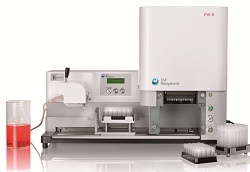TAP Biosystems reports that I-Stem, the Institute for Stem cell Therapy and Exploration of Monogenic diseases, has selected two of its lab automation systems for installation at its headquarters at Evry, on the southern edge of Paris.
The Tap CompacT SC automated cell culture system, and Fill-It automated cryovial filing and capping system, are employed to generate and bank a range of pluripotent stem cells.
Researchers at I-Stem use the CompacT SC to automate differentiation and expansion of stem cells. This should allow the generation of human pluripotent cell lines of consistent quality.
They then use the Fill-It to prepare these cell lines for storage in the centre’s biobank, the largest human embryonic stem cell bank in France. Two varieties of stem cell are produced – those containing specific disease mutations, and those for use in clinical trials as cellular therapies. Both may enable advances in the treatment of debilitating human diseases.
Dr Yacine Laabi, senior group leader of stem cell biotechnologies at I-Stem said: “My group is working with human pluripotent induced progenitor cells for skin, muscle, neurons and retina. We decided two years ago that automation was essential because it would offer us greater reproducibility in both process and cell quality. We reviewed systems from several companies but chose CompacT SC as the published literature shows the system works well with mesenchymal and neuronal stem cells and we believed it would be most suited to our research.
“We use the CompacT SC to differentiate cells into specific lineages and it is ideal for this because the system has chilled storage for expensive cytokines, which allows us to add these at the correct time to maintain our cell lines in specific states. By using a newly developed flask adaptor, we can also process T75 flasks, so we can work with smaller scale cultures using less of the costly media and growth factors. We then use Fill-It to dispense our final stem cells harvests into cryovials for storage. This integrated workflow improves our process standardisation and reduces the chance of contamination because human contact with each cell line is kept to a minimum.”

